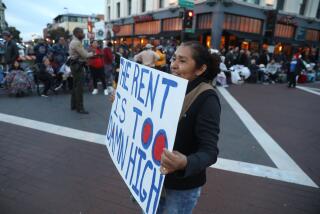Fannie and Freddie, old and new
It’s been nearly 60 years since Fannie Mae -- the Federal National Mortgage Assn. -- was formed to expand home ownership. Many observers of today’s sub-prime mortgage debacle are arguing for Congress to let Fannie Mae and its twin, Freddie Mac (the Federal Home Loan and Mortgage Corp.), use their institutional power to stabilize markets by buying up more mortgage debt. But the changes being proposed avoid reckoning with more basic questions: Should Fannie and Freddie compete with private lenders or return to their original mandate of helping borrowers get credit they couldn’t otherwise get?
FOR THE RECORD:
Mortgage: Christopher Thornberg’s Op-Ed piece on Friday about Fannie Mae (the Federal National Mortgage Assn.) and Freddie Mac (the Federal Home Loan and Mortgage Corp.) said that Fannie Mae had been around for nearly 60 years. It has been nearly 70 years since it was formed in 1938. —
When Fannie Mae was created, financial markets were still in turmoil from the banking collapse that began at the start of the Depression. The lack of liquidity shut many potential home buyers out of the market. Fannie Mae solved this problem by buying mortgages from lenders that met certain criteria. This allowed local lenders to make more loans to home buyers.
As financial markets grew more sophisticated, the role of a federally mandated mortgage guarantor became increasingly superfluous. In 1968, Congress turned Fannie Mae into an entity that was government-chartered and closely regulated but privately owned and run. Two years later, Freddie Mac was created -- a rival organization under similar rules. While the government does not directly guarantee the debt held by these firms (as is often assumed), their size and the implicit guarantee created by their special chartered status have allowed them to dominate the market by borrowing at lower rates than fully private rivals. Even as late as 2000, Fannie and Freddie had trillions of dollars in mortgages on their books.
Then came the brave new world of alternative finance, including sophisticated mortgage-backed bond issues and new mortgage products such as sub-prime and limited-documentation loans. Fannie and Freddie began to lose market share. These new loan types also allowed Americans to speculate on real estate as never before, further pushing the two firms out of the limelight as prices grew far beyond the limits for individual loans allowed by Freddie’s and Fannie’s guidelines.
Unfortunately this brave new world turned out to be the same old world, and “alternative financing” has turned into “unwise financing.” As unprecedented increases in delinquencies and foreclosures have sent panicked bond holders looking for the exits, the relative stability of Freddie and Fannie is looking more attractive. The two firms are promising to help provide financing for homeowners in financial difficulties. But to do so, they need Congress to raise limits on both the loans they can fund and their overall portfolios.
This move would give Fannie and Freddie a chance to recapture market share and profits but would have little effect on the housing crisis. That’s because even at their higher limits, the two institutions would not be helping out borrowers stuck in the worst loans. Too many people are carrying mortgages they simply cannot afford, and unless Fannie and Freddie subsidize their loan payments (which they are not offering to do), there is little the institutions can do to help. They would only skim off the best loans in the mortgage pools, leaving the worst for the market to bear.
Ironically, Fannie and Freddie have become the opposite of what they were. They are now lenders to safe markets, while private institutions serve markets that were once liquidity-deprived.
The mess in the mortgage markets will take years to clean up. Investors will incur losses, and new homeowners will lose their homes. However, not every loan will go bad. Alternative mortgages in some cases went to credit-poor individuals who will be able to pay them off, which means they could buy a home when the regulated market failed them.
As Congress considers new regulations to control unwise lending, it may find that some of the restrictions placed on Fannie and Freddie -- regarding documentation, share of adjustable-rate mortgages and debt-to-income ratios -- make sense for the entire market. It is also clear that easing the restrictions on Freddie’s and Fannie’s loan size would do little to help the underserved.
So the real question is what to do with these government-sponsored entities at a fundamental level. One answer is to set them loose to do as they please -- possibly in tandem with a new set of industrywide regulations. In this case, we would have no more chartered firms at all, and Fannie and Freddie would compete like everybody else in the secondary-mortgage market.
The other answer is to get Freddie and Fannie back into the business Fannie was created for in 1938: helping to provide liquidity in markets that private financial institutions will not or cannot serve.
If any group of Americans needs federal mortgage guarantees, it is not the people paying large but less-risky mortgages but the people at the bottom of the market -- lower-income and first-time buyers who are suffering the worst losses in the sub-prime crisis and are not going to be helped by loan-size rule changes. These folks are today’s counterparts to the people Fannie Mae was originally designed to serve.
Christopher Thornberg is a founding partner of research and consulting firm Beacon Economics and teaches at the Rady School of Management at UC San Diego.
More to Read
A cure for the common opinion
Get thought-provoking perspectives with our weekly newsletter.
You may occasionally receive promotional content from the Los Angeles Times.






